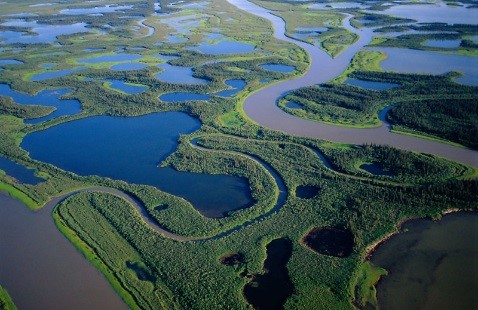Checking on the health of Canada’s Great River
Written by Sophie Taddeo, Freshwater Analyst
Did you know that Canada’s North is home to one of the very few remaining large wild rivers in the world? And did you know that at 1,800 kilometers in length, this also happens to be the longest river in the country? You won’t be surprised, then, to find out that this river is the mighty Mackenzie, or “Deh Cho”, which in the Dene language means Great River. It is a great – and gorgeous – river indeed, as you can see for yourself!
As you can imagine, evaluating the water quality, quantity, and aquatic communities of such a large river basin – it’s roughly the size of Spain – can be quite challenging. Fortunately, WWF-Canada’s Freshwater team was able to work with many local experts and enthusiastic communities (from Fort Good Hope to Norman Wells and Inuvik) that have dedicated a great deal of time and energy to protecting, studying, and understanding the water bodies they use and cherish.
Thanks to the hard and consistent work of federal agencies, multi-university research programs, and local communities supported by Northwest Territories’ Community-Based Monitoring Program, we were able to source water quality measurements taken as early as 1960! Our analyses of these excellent datasets revealed that the water quality of the Mackenzie River Basin is not only good, but has also significantly improved over the last five decades.
We found similar patterns in the bug communities present in the southern portion of the basin. The presence of certain species that are very sensitive to environmental change show that these areas have been quite stable for the past five years. The communities in the northern part of the basin haven’t been monitored recently, which is why we could not confidently create a bug score at the watershed scale.
The picture is not all bright, however. While the Mackenzie has remained fairly untouched, we nonetheless noted considerable changes in the quantity and flow cycles. Out of the 13 water monitoring stations studied, many showed substantial increases in both total annual discharge and monthly median discharge. In addition, we noticed that the annual water peak, called snowmelt runoff, that follows the rapid melting of snow in spring is now occurring earlier than it used to only a couple of decades ago. As a consequence of this, we attributed a score of “poor” to Mackenzie’s water flow metric, and scores ranking from “very poor” to “good” to the six sub-watershed that it includes.
This majestic river will likely face great challenges in the years to come. Changes in climate, and increasing interest in the oil and gas reserve that the basin shelters could put local water health at risk. It is nonetheless comforting and encouraging to see that many residents are committed to protecting the Mackenzie River, and are spending more and more time and energy studying this vital watershed. May the Mackenzie remain wild for a long, long time!
WWF-Canada would like to thank The Walter and Duncan Gordon Foundation for their support of this important work.


